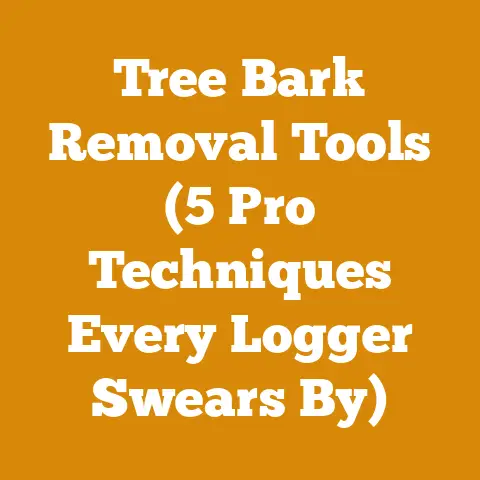Husqvarna 261 Specifications (Pro Insights for Efficient Woodcutting)
The Husqvarna 261: A Woodcutter’s Resale Gem & Cost Analysis
The Husqvarna 261.
Just the name conjures up images of seasoned loggers and stacks of neatly piled firewood.
It’s a chainsaw that’s earned its stripes, not just for its performance in the woods, but also for its remarkable resale value.
In this article, I’ll delve deep into the Husqvarna 261, examining its specifications, performance, and, most importantly, how to factor its use (and even resale) into your wood processing and firewood preparation budget.
I’ll also share some personal anecdotes and insights I’ve gained over the years working with chainsaws and processing wood.
Why Resale Value Matters
Before we get into the nitty-gritty specifications, let’s talk about resale value.
Why is it so important?
Because it affects your overall cost of ownership.
A chainsaw that holds its value is, in essence, a better investment.
Think of it this way: if you buy a new chainsaw for $600 and sell it for $300 after five years of use, your actual cost of ownership is $300 (plus maintenance and fuel).
Conversely, a chainsaw that depreciates rapidly can end up costing you significantly more in the long run.
The Husqvarna 261 has earned a reputation for holding its value due to its robust construction, reliable performance, and popularity among professionals.
This means that even after years of hard use, a well-maintained 261 can still fetch a decent price on the used market, reducing your overall cost.
Husqvarna 261: Specifications and Performance
Let’s begin by taking a closer look at the Husqvarna 261’s specifications.
These specifications provide a baseline for understanding the saw’s capabilities and how they translate into real-world performance.
Engine Specifications
The heart of any chainsaw is its engine, and the Husqvarna 261 boasts a powerful one for its class.
- Engine Displacement: 61.5 cc (3.75 cu. in.)
- Power Output: 3.2 kW / 4.3 hp
- Maximum Power Speed: 9,000 rpm
- Idling Speed: 2,700 rpm
- Cylinder Bore: 48 mm (1.89 in.)
- Cylinder Stroke: 34 mm (1.34 in.)
- Ignition System: SEM AM50
- Spark Plug: NGK BPMR7A
- Electrode Gap: 0.5 mm (0.02 in.)
- Carburetor: Zama C3-EL17
Why These Specs Matter: The 61.5cc engine provides a sweet spot of power and weight, making it suitable for a wide range of tasks, from felling smaller trees to bucking firewood.
The high maximum power speed (9,000 rpm) ensures fast chain speed for efficient cutting.
Cutting Equipment
The cutting equipment, including the bar and chain, are critical for effective woodcutting.
- Recommended Bar Length: 13″ to 20″ (33 cm to 50 cm)
- Chain Pitch: 0.325″
- Chain Gauge: 0.058″ (1.5 mm)
- Chain Speed at Max Power: 20.7 m/s (68 ft/s)
Why These Specs Matter: The versatility of the recommended bar lengths allows you to adapt the saw to different cutting tasks.
A shorter bar is ideal for limbing and smaller firewood, while a longer bar is better suited for felling larger trees.
The 0.325″ chain pitch offers a good balance between cutting speed and durability.
Dimensions and Weight
The dimensions and weight of the chainsaw directly impact its handling and maneuverability.
- Weight (Excluding Cutting Equipment): 6.0 kg (13.2 lbs)
- Fuel Tank Volume: 0.75 liters (1.59 US pints)
- Oil Tank Volume: 0.4 liters (0.85 US pints)
Why These Specs Matter: At 13.2 lbs (without cutting equipment), the Husqvarna 261 is relatively lightweight for its power, making it less fatiguing to use for extended periods.
The fuel and oil tank capacities are sufficient for a reasonable amount of cutting before needing to refuel or top off the oil.
Noise and Vibration Levels
Noise and vibration levels are important considerations for operator comfort and safety.
- Sound Power Level (LWA): 115 dB(A)
- Sound Pressure Level at Operator’s Ear: 102 dB(A)
- Equivalent Vibration Level (Front Handle): 3.5 m/s²
- Equivalent Vibration Level (Rear Handle): 4.5 m/s²
Why These Specs Matter: Chainsaws are inherently noisy, so wearing hearing protection is crucial.
The vibration levels, while not excessive, can still contribute to fatigue over time.
Using proper technique and taking breaks can help minimize the impact of vibration.
Budgeting for Chainsaw Use: Initial Purchase vs. Total Cost of Ownership
When budgeting for chainsaw use, it’s tempting to focus solely on the initial purchase price.
However, this is a mistake.
A more accurate approach is to consider the total cost of ownership (TCO) over the lifespan of the saw.
This includes not only the initial purchase price but also all the ongoing expenses associated with using and maintaining the chainsaw.
Components of Total Cost of Ownership
- Initial Purchase Price: The price you pay for the chainsaw itself.
- Fuel Costs: The cost of gasoline and oil mix.
- Bar and Chain Costs: The cost of replacing bars and chains as they wear out.
- Maintenance Costs: The cost of routine maintenance, such as air filter cleaning, spark plug replacement, and carburetor adjustments.
- Repair Costs: The cost of repairing the chainsaw if it breaks down.
- Personal Protective Equipment (PPE): The cost of essential safety gear, such as a helmet, hearing protection, eye protection, gloves, and chaps.
- Depreciation: The decrease in the chainsaw’s value over time.
Estimating Fuel Costs
Fuel costs can add up quickly, especially if you use your chainsaw frequently.
To estimate your fuel costs, you need to consider the following factors:
- Fuel Consumption Rate: The amount of fuel the chainsaw consumes per hour of operation.
- Fuel Price: The price of gasoline per gallon or liter.
- Usage Hours: The number of hours you expect to use the chainsaw per year.
Fuel Consumption Rate: The Husqvarna 261, being a 61.5cc engine, will consume roughly 0.4 to 0.6 liters of fuel per hour under heavy load.
This is an estimate, and the actual consumption can vary depending on the type of wood you’re cutting, the sharpness of your chain, and your operating technique.
Fuel Price: Fuel prices fluctuate constantly.
To get an accurate estimate, check the current price of gasoline in your area.
Remember to factor in the cost of two-stroke oil, which is typically mixed with gasoline at a ratio of 50:1 (50 parts gasoline to 1 part oil).
High-quality synthetic two-stroke oil can extend engine life and reduce carbon buildup.
Usage Hours: Estimate the number of hours you’ll use the chainsaw per year.
This will depend on the size of your property, the amount of firewood you need to cut, and the frequency of your wood processing projects.
Example Calculation:
- Fuel Consumption Rate: 0.5 liters/hour
- Fuel Price: $1.20/liter (including two-stroke oil)
- Usage Hours: 50 hours/year
Estimated Annual Fuel Cost: 0.5 liters/hour * $1.20/liter * 50 hours/year = $30.00/year
Estimating Bar and Chain Costs
The bar and chain are consumable items that will need to be replaced periodically.
The lifespan of a bar and chain depends on several factors, including:
- Wood Type: Hardwoods like oak and maple will wear out bars and chains faster than softwoods like pine and fir.
- Cutting Conditions: Cutting dirty or sandy wood will accelerate wear.
- Maintenance: Regularly sharpening the chain and lubricating the bar will extend their lifespan.
Bar Lifespan: A good quality bar can last for several years with proper care.
However, it will eventually wear out due to friction and heat.
Signs of wear include a worn groove, bent rails, and difficulty keeping the chain tight.
Chain Lifespan: Chains typically need to be replaced more frequently than bars.
The lifespan of a chain depends on the factors mentioned above, as well as the quality of the chain.
A high-quality chain made from durable steel will last longer than a cheaper chain.
A good chain might last 20-40 hours of cutting time, but this can vary widely.
Estimating Replacement Costs:
- Bar: $40-$80 (depending on length and quality)
- Chain: $20-$40 (depending on length and quality)
Example Calculation:
- Bar Replacement Frequency: Every 3 years
- Chain Replacement Frequency: Every year
- Bar Cost: $60
- Chain Cost: $30
Estimated Annual Bar and Chain Cost: ($60 / 3 years) + $30 = $50/year
Estimating Maintenance Costs
Regular maintenance is essential for keeping your chainsaw running smoothly and preventing costly repairs.
Common maintenance tasks include:
- Air Filter Cleaning: Clean the air filter after each use to prevent dirt and debris from entering the engine.
- Spark Plug Replacement: Replace the spark plug annually or as needed.
- Carburetor Adjustment: Adjust the carburetor periodically to ensure proper fuel-air mixture.
- Chain Sharpening: Sharpen the chain regularly to maintain cutting efficiency.
- Bar Lubrication: Keep the bar and chain properly lubricated to reduce friction and wear.
Cost of Maintenance Supplies:
- Air Filter: $5-$10
- Spark Plug: $5-$10
- Two-Stroke Oil: Varies, but budget around $20-$30 per year for a good quality synthetic oil.
- Bar and Chain Oil: $10-$20 per gallon.
Labor Costs: If you’re not comfortable performing maintenance tasks yourself, you’ll need to factor in the cost of labor.
Chainsaw repair shops typically charge $50-$100 per hour for labor.
Example Calculation (DIY Maintenance):
- Air Filter: $8
- Spark Plug: $7
- Two-Stroke Oil: $25
- Bar and Chain Oil: $15
Estimated Annual Maintenance Cost: $8 + $7 + $25 + $15 = $55/year
Estimating Repair Costs
Even with proper maintenance, chainsaws can break down.
Repair costs can vary widely depending on the nature of the problem.
Minor repairs, such as replacing a fuel line or a starter cord, may only cost a few dollars.
However, major repairs, such as replacing the engine or the crankshaft, can cost hundreds of dollars.
Setting Aside a Repair Fund: It’s a good idea to set aside a repair fund to cover unexpected repair costs.
A reasonable amount to budget for repairs is 5-10% of the chainsaw’s initial purchase price per year.
Example Calculation:
- Initial Purchase Price: $600
- Repair Budget: 7.5% of Purchase Price
Estimated Annual Repair Budget: $600 * 0.075 = $45/year
Estimating PPE Costs
Personal protective equipment (PPE) is essential for safe chainsaw operation.
The minimum PPE you should wear includes:
- Helmet: Protects your head from falling branches and debris.
- Hearing Protection: Protects your ears from the loud noise of the chainsaw.
- Eye Protection: Protects your eyes from flying wood chips and debris.
- Gloves: Protect your hands from cuts and abrasions.
- Chainsaw Chaps: Protect your legs from accidental contact with the chain.
Cost of PPE:
- Helmet: $50-$100
- Hearing Protection: $20-$50
- Eye Protection: $10-$30
- Gloves: $20-$40
- Chainsaw Chaps: $80-$150
Lifespan of PPE: PPE should be replaced as needed.
Helmets should be replaced every 3-5 years, or sooner if they’ve been impacted.
Chainsaw chaps should be replaced if they’ve been cut by the chain.
Example Calculation:
- Helmet: $75 (replaced every 5 years)
- Hearing Protection: $35 (replaced every 3 years)
- Eye Protection: $20 (replaced every 2 years)
- Gloves: $30 (replaced every year)
- Chainsaw Chaps: $120 (replaced every 5 years)
Estimated Annual PPE Cost: ($75 / 5 years) + ($35 / 3 years) + ($20 / 2 years) + $30 + ($120 / 5 years) = $90.67/year
Estimating Depreciation
Depreciation is the decrease in the chainsaw’s value over time.
Chainsaws depreciate due to wear and tear, obsolescence, and market factors.
Calculating Depreciation: There are several ways to calculate depreciation.
A simple method is to use the straight-line method, which assumes that the chainsaw depreciates at a constant rate over its useful life.
Straight-Line Depreciation Formula:
- Annual Depreciation = (Initial Purchase Price – Salvage Value) / Useful Life
Salvage Value: The estimated value of the chainsaw at the end of its useful life.
Useful Life: The estimated number of years the chainsaw will be used.
Example Calculation:
- Initial Purchase Price: $600
- Salvage Value: $200 (estimated resale value after 5 years)
- Useful Life: 5 years
Annual Depreciation: ($600 – $200) / 5 years = $80/year
Total Cost of Ownership Calculation
Now that we’ve estimated all the individual cost components, we can calculate the total cost of ownership.
- Initial Purchase Price: $600
- Annual Fuel Cost: $30
- Annual Bar and Chain Cost: $50
- Annual Maintenance Cost: $55
- Annual Repair Budget: $45
- Annual PPE Cost: $90.67
- Annual Depreciation: $80
Total Annual Cost of Ownership: $350.67 Total Cost of Ownership (5 years): ($350.67 * 5) + $600 = $2353.35
This calculation shows that the total cost of owning a chainsaw is significantly higher than just the initial purchase price.
By considering all the associated costs, you can make a more informed decision about whether to buy a particular chainsaw and how to budget for its use.
Understanding these factors is crucial for accurate budgeting and efficient project management.
Wood Species
The type of wood you’re processing has a significant impact on cost.
Hardwoods like oak, maple, and hickory are generally more expensive than softwoods like pine, fir, and spruce.
This is because hardwoods are denser, slower-growing, and require more effort to harvest and process.
Timber Prices: Timber prices vary widely depending on the species, quality, and location.
According to recent data from the U.S.
Forest Service, the average price for standing timber (stumpage) in the eastern United States is:
- Oak: $40-$80 per thousand board feet (MBF)
- Maple: $30-$60 per MBF
- Pine: $15-$30 per MBF
Firewood Prices: Firewood prices also vary depending on the species.
Hardwoods like oak and maple are typically sold at a premium compared to softwoods.
The average price for a cord of seasoned firewood in the United States is:
- Oak: $200-$350 per cord
- Maple: $180-$300 per cord
- Pine: $120-$200 per cord
My Experience: I once took on a project to mill some oak logs into lumber for a custom furniture build.
The oak was significantly more expensive than the pine I usually work with, but the finished product was well worth the extra cost.
The density and grain of the oak gave the furniture a beautiful, durable quality that I couldn’t achieve with pine.
Wood Quality
The quality of the wood also affects its price and processing costs.
Wood with defects, such as knots, rot, or insect damage, will be less valuable and more difficult to process.
Grading Standards: Timber is typically graded according to established standards, such as those developed by the National Hardwood Lumber Association (NHLA).
These standards consider factors such as the size and number of knots, the presence of rot, and the overall straightness of the log.
Impact on Processing: Low-quality wood may require more time and effort to process, as you’ll need to work around defects and discard unusable portions.
This can increase labor costs and reduce the overall yield.
Location and Accessibility
The location of the wood and its accessibility can significantly impact harvesting and transportation costs.
Wood that is located in remote areas or on steep slopes will be more difficult and expensive to harvest.
Transportation Costs: Transportation costs depend on the distance the wood needs to be transported, the type of vehicle used, and the fuel prices.
Long-distance transportation can add significantly to the overall cost of wood processing.
Accessibility Challenges: I once had to harvest some timber from a remote mountainside.
The terrain was so steep that I had to use a winch and cable system to move the logs to a more accessible location.
This added significantly to the time and cost of the project.
Labor Costs
Labor costs are a major component of wood processing expenses.
Whether you’re hiring a logging crew or handling the work yourself, it’s important to accurately estimate labor costs.
Logging Crew Wages: Logging crew wages vary depending on the location, the size of the crew, and the type of work being performed.
According to the Bureau of Labor Statistics, the median hourly wage for logging workers in the United States is around $20.
Firewood Handlers: If you’re preparing firewood, you may need to hire someone to help with cutting, splitting, and stacking the wood.
The hourly wage for firewood handlers typically ranges from $15-$25 per hour.
My Experience: When I started processing firewood, I tried to do everything myself.
However, I quickly realized that it was too much work for one person.
Hiring a helper to split and stack the wood significantly increased my efficiency and allowed me to focus on the more skilled tasks, such as felling trees and operating the chainsaw.
Tool Costs
The cost of tools and equipment is another important factor to consider.
Chainsaws, log splitters, skidding winches, and other specialized tools can represent a significant investment.
Chainsaw Costs: Chainsaw costs vary depending on the size, power, and features of the saw.
Professional-grade chainsaws can cost anywhere from $500 to $1500 or more.
Log Splitter Costs: Log splitters range in price from a few hundred dollars for a manual splitter to several thousand dollars for a hydraulic splitter.
The size and power of the splitter will depend on the size and type of wood you’re splitting.
Rental Options: Renting tools and equipment can be a cost-effective alternative to purchasing them, especially if you only need them for occasional use.
Tool rental companies typically charge by the day, week, or month.
Cost Comparison Table:
Permits and Regulations
Depending on your location and the type of wood processing you’re doing, you may need to obtain permits and comply with regulations.
These can add to the overall cost of the project.
Logging Permits: Logging permits are typically required for commercial logging operations.
These permits may specify the types of trees that can be harvested, the methods of harvesting, and the environmental protection measures that must be taken.
Firewood Permits: Some areas require permits for cutting firewood on public lands.
These permits typically specify the amount of firewood that can be harvested, the location where it can be harvested, and the season when it can be harvested.
Environmental Regulations: Environmental regulations may require you to take measures to protect water quality, prevent soil erosion, and protect wildlife habitat.
These measures can add to the cost of wood processing.
Seasonality
The time of year can also affect wood processing costs.
Harvesting timber in the winter can be more difficult due to snow and ice.
Drying firewood in the summer can be faster and more efficient than drying it in the winter.
Timber Harvesting: Timber harvesting is often more expensive in the winter due to the challenges of working in cold weather and snow.
However, winter harvesting can also have some advantages, such as reduced soil compaction and less damage to vegetation.
Firewood Drying: Firewood needs to be properly seasoned (dried) before it can be burned efficiently.
The drying time depends on the type of wood, the climate, and the stacking method.
Softwoods like pine can dry in as little as six months, while hardwoods like oak may take a year or more.
Formula for Estimating Drying Time:
- Drying Time (months) = (Moisture Content (%) – Target Moisture Content (%)) / Drying Rate (% per month)
Example:
- Initial Moisture Content: 50%
- Target Moisture Content: 20%
- Drying Rate: 5% per month
Drying Time: (50% – 20%) / 5% per month = 6 months
Cost Optimization Tips
Now that we’ve covered the various cost factors, let’s look at some practical tips for optimizing your wood processing budget.
Negotiate Timber Prices
Don’t be afraid to negotiate timber prices with landowners or timber buyers.
Prices can vary depending on market conditions, the quality of the wood, and the volume of timber being purchased.
Get Multiple Bids: Get multiple bids from different timber buyers to ensure you’re getting a fair price.
Offer a Win-Win: Look for ways to create a win-win situation for both you and the landowner.
For example, you could offer to clean up the logging site after harvesting or to plant new trees.
Improve Efficiency
Improving efficiency can significantly reduce labor costs and fuel consumption.
Sharpen Chains Regularly: A sharp chain cuts faster and requires less effort, reducing fuel consumption and extending the life of the chain.
Use Proper Cutting Techniques: Using proper cutting techniques can reduce the risk of accidents and improve efficiency.
Optimize Log Splitting: Optimize your log splitting process by using the right size splitter for the job and by splitting logs in the most efficient way.
Minimize Waste
Minimizing waste can save you money on timber purchases and reduce disposal costs.
Plan Carefully: Plan your wood processing projects carefully to minimize waste.
Use All Usable Wood: Use all usable wood, even if it’s not perfect.
Smaller pieces of wood can be used for kindling, craft projects, or other purposes.
Recycle or Reuse Waste Wood: Recycle or reuse waste wood whenever possible.
Wood chips can be used for mulch, sawdust can be used for animal bedding, and larger pieces of waste wood can be burned in a wood stove.
Perform Routine Maintenance
Performing routine maintenance on your tools and equipment can prevent costly repairs and extend their lifespan.
Follow Maintenance Schedules: Follow the manufacturer’s recommended maintenance schedules for your chainsaws, log splitters, and other tools.
Keep Tools Clean: Keep your tools clean and lubricated to prevent rust and corrosion.
Store Tools Properly: Store your tools in a dry, secure location to protect them from the elements.
Consider Alternative Energy Sources
If you’re processing wood for firewood, consider using alternative energy sources, such as solar power or wind power, to dry the wood.
Solar Kilns: Solar kilns can be used to dry firewood more quickly and efficiently than air drying.
Wind Power: Wind power can be used to power fans that circulate air through firewood piles, speeding up the drying process.
Track Expenses Carefully
Tracking your expenses carefully is essential for effective budget management.
Use Accounting Software: Use accounting software or a spreadsheet to track your income and expenses.
Analyze Your Data: Analyze your data regularly to identify areas where you can save money.
Adjust Your Budget: Adjust your budget as needed based on your actual expenses.
Case Studies
To illustrate the principles discussed above, let’s examine a couple of case studies:
Case Study 1: Small-Scale Firewood Supplier
A small-scale firewood supplier in rural Maine processes and sells firewood as a part-time business.
They harvest timber from their own property and sell seasoned firewood to local customers.
Cost Analysis:
- Timber Costs: $0 (harvested from own property)
- Labor Costs: $15/hour (self-employed)
- Tool Costs: $500/year (chainsaw, log splitter maintenance)
- Fuel Costs: $200/year
- Transportation Costs: $100/year
- Marketing Costs: $50/year
Total Annual Costs: $850 + (Labor Hours * $15)
Revenue: $250/cord (average price)
Profitability: Depends on the number of cords sold and the number of labor hours required.
Cost Optimization Strategies:
- Improve efficiency by using a more powerful log splitter.
- Reduce fuel costs by using a more fuel-efficient chainsaw.
- Increase marketing efforts to attract more customers.
Case Study 2: Logging Company
A logging company in the Pacific Northwest harvests timber from private and public lands.
They employ a crew of 10 workers and use heavy equipment to fell, skid, and load logs.
Cost Analysis:
- Timber Costs: $50/MBF (average price)
- Labor Costs: $25/hour (average wage)
- Equipment Costs: $50,000/year (depreciation, maintenance, fuel)
- Transportation Costs: $20/MBF
- Permit Costs: $5/MBF
Total Annual Costs: (Timber Volume * $75) + (Labor Hours * $25) + $50,000
Revenue: $200/MBF (average price)
Profitability: Depends on the volume of timber harvested and the efficiency of the operation.
Cost Optimization Strategies:
- Negotiate better timber prices with landowners.
- Improve efficiency by using more advanced logging equipment.
- Reduce transportation costs by optimizing truck routes.
- Minimize waste by using precision harvesting techniques.
Actionable Takeaways and Next Steps
Budgeting for wood processing and firewood preparation can seem daunting, but by breaking down the costs into individual components and implementing cost optimization strategies, you can effectively manage your expenses and increase your profitability.
Here are some actionable takeaways and next steps:
- Assess Your Needs: Determine the scope of your wood processing or firewood preparation project.
How much wood do you need to process?
What type of wood will you be working with?
What tools and equipment will you need? - Estimate Your Costs: Use the information and formulas provided in this article to estimate your costs for timber, labor, tools, fuel, transportation, and other expenses.
- Create a Budget: Create a detailed budget that outlines your expected income and expenses.
- Track Your Expenses: Track your expenses carefully and compare them to your budget.
- Adjust Your Budget as Needed: Adjust your budget as needed based on your actual expenses and any changes in market conditions.
- Implement Cost Optimization Strategies: Implement the cost optimization strategies discussed in this article to reduce your expenses and increase your profitability.
- Seek Professional Advice: If you’re unsure about any aspect of wood processing or firewood preparation, seek professional advice from a forester, logger, or other expert.
Final Thoughts
Wood processing and firewood preparation can be rewarding and profitable activities.
By carefully planning and budgeting your projects, you can ensure that they are both successful and sustainable.
Remember that the Husqvarna 261, with its reputation for reliability and strong resale value, can be a valuable asset in your wood processing endeavors.
And by considering all the factors discussed in this article, you can make informed decisions that will help you achieve your goals.
So, get out there, put these tips into practice, and enjoy the satisfaction of working with wood!






